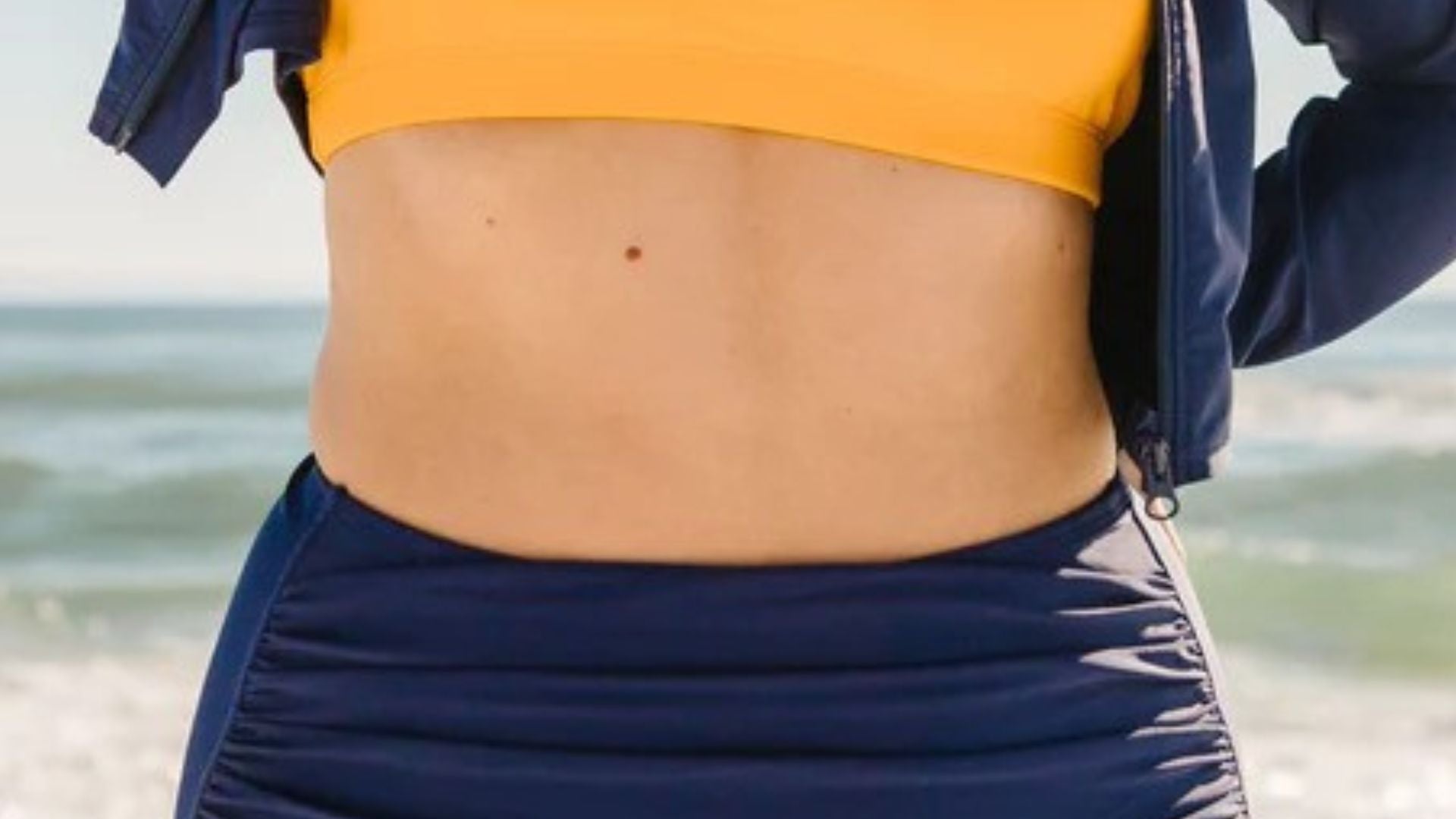
How to shrink a bikini top
Bikini tops become loose and unflattering over time. But don’t throw your old bikini top away just yet. Shrink it back to its original size with a few simple methods.
Read on to learn how to restore that perfect fit to your bikini.
Quick links:
How to adjust bikini tops without shrinking
Cold water method
The cold water method works well for delicate fabrics and suits you don't want to expose to high heat. It relies on the natural tendency of certain fibers to contract when cold.
Here’s how to tighten your bikini top with cold water:
- Fill a sink or basin with cold water. Add ice cubes to make it extra cold.
- Dunk your bikini top in the icy water.
- Let the top soak for thirty minutes to an hour.
- Remove the top from the water. Don't wring or twist.
- Gently squeeze out water.
- Lay the bikini top flat on a clean, dry towel.
- Roll the towel with the top inside to remove more water.
- Reshape the top if needed, then lay it flat to air dry.
- Once dry, try on the top to check the fit.
This method may require multiple attempts for noticeable results. It's safer for your swimwear but takes longer than hot water techniques.
Washing machine technique
The washing machine technique uses controlled heat and agitation to tighten the fabric fibers.
- Set your washing machine to the highest heat setting.
- Add your bikini top to the machine. Wash it alone or with similar colors.
- Use a small amount of mild detergent. Avoid harsh chemicals.
- Run a full wash cycle.
- When the cycle ends, remove the top.
- Gently squeeze out residual water. Don't wring or twist.
- Lay the top flat on a clean, dry towel.
- Reshape the top if needed.
- Allow it to air dry completely.
- Try on the top to check the fit.
This method works well for many synthetic fabrics. Always check your bikini top's care label first. Some delicate materials may not withstand machine washing.
The boiling water method
The boiling water method uses extreme heat to contract and tighten swimsuit fibers. This technique works best for bikini tops with synthetic fibers, such as nylon or spandex.
Here’s how to tighten your bikini top with boiling water:
- Boil clean water in a large pot. Add a cup of table salt to shrink fibers more.
- Remove the pot from heat once the water reaches a rolling boil.
- Carefully submerge your bikini top in the hot water.
- Soak the bikini top for 5–10 minutes, depending on desired shrinkage.
- Remove it with tongs or a wooden spoon. Be careful—it will be hot.
- Gently squeeze out excess water. Don't wring or twist.
- Place the bikini top on a clean towel. Roll the towel to remove the remaining water.
- Lay the top flat and air dry away from sunlight and heat sources.
Use this method sparingly. Too much heat exposure weakens bikini top fabrics over time.
Heat application techniques
Heat application techniques use direct heat to shrink bikini tops. These methods work well for synthetic fabrics that respond to heat. The three main heat application techniques are:
- Hair dryer method
- Iron method
- Clothes dryer method
Hair dryer method
The hair dryer method is a more controlled and gentle way to shrink your bathing suit. Here’s how to tighten your swimsuit with a hair dryer:
- Dampen the bikini top slightly.
- Set the hair dryer to medium heat.
- Hold the dryer about six inches from the fabric.
- Move the dryer constantly to avoid overheating one spot.
- Focus on areas that need more shrinking.
- Check the fit frequently to avoid over-shrinking.
Iron method
The iron method uses direct heat to shrink the stretched-out swimsuit. The heat from the iron contracts the fibers and restores the swimsuit's original shape.
Here’s how to tighten your bikini top with an iron:
- Set the iron to low or medium heat.
- Place a thin towel over the bikini top.
- Press the iron gently over the towel.
- Move the iron steadily, don't leave it in one place.
- Allow the top to cool before trying it on.
- Check the fit after each pass with the iron.
Clothes dryer method
Dryer heat causes fibers to contract, restoring the bathing suit's original shape and size. Here’s how to tighten your bikini top with a dryer:
- Place the damp top in the dryer.
- Set the dryer to the lowest heat setting.
- Add a few dry towels to the dryer for even heat distribution.
- Run the dryer for 15–20 minutes.
- Check the top's fit. If it needs more shrinking, repeat steps five and six.
- Once satisfied with the fit, lay the bikini top flat to cool and finish air-drying.
How to adjust bikini tops without shrinking
Sometimes, you can fix a loose bikini top without resorting to shrinking methods. These techniques work well for minor fit issues:
- Tighten the straps. Adjust the straps to sit snugly on your shoulders. If possible, make them non-adjustable by sewing them.
- Use safety pins. Gather excess fabric at the back or sides. Secure with small safety pins on the inside of the top. Be careful not to create visible bulges.
- Sew darts. Pinch and pin small folds where the top is loose. Hand-sew these darts to take in extra fabric. Focus on areas under the arms or at the center of the cups.
- Add elastic. Sew a thin elastic band along the top edge of the cups. This creates a snugger fit without altering the overall size.
- Use bikini inserts. Add removable padding to fill out the cups. This works well if the top is only slightly loose.
- Crossover hack. For halter styles, cross the straps at the back of your neck. This pulls the cups closer together and creates a tighter fit.
Choose high-quality SwimZip swimwear
SwimZip offers swimwear that's built to last and keep you protected. Our swimwear uses durable, quick-drying fabrics. We blend nylon and spandex, with a polyester lining for comfort and support. Our high-quality swimwear provides long-lasting UPF 50+ sun protection.
In our collection, you'll find men's swim trunks, women's swimwear, kids' sunsuits, sun hats, rash guards, and accessories. SwimZip has something for everyone in the family.
As a trusted UPF 50+ brand, SwimZip focuses on keeping you and your loved ones safe from harmful UV rays. Our commitment to quality means you can enjoy the water without worrying about your swimwear's fit or protection.
Swimsuits FAQ
What are bikini tops made from?
Bikini tops can be made from many different fabrics. Each material fits, wears, and shrinks differently. Before you resize your bikini top, you should know what it's made of.
Here's what you need to know about bikini top materials:
- Polyester. A synthetic fabric that resists chlorine and dries quickly. Polyester swimsuits keep their shape well and are easy to care for.
- Nylon. Another synthetic material that offers more stretch than polyester. Nylon bathing suits hug the body and provide a comfortable fit.
- Spandex. Often mixed with polyester or nylon, spandex gives swimwear its elasticity. It helps bikini tops maintain their shape and fit snugly.
- Cotton blends. Some bikini tops contain cotton mixed with synthetic fibers. These suits feel soft but may absorb more water and lose shape faster than full synthetics.
- Microfiber. A very fine synthetic fabric that dries rapidly and feels smooth against the skin. Microfiber swimsuits often resist fading from the sun and chlorine exposure.
Each of these materials responds differently to shrinking techniques. Synthetic fabrics generally hold up better to heat and water exposure than natural fibers. Before attempting to shrink your bikini top, check its care instructions, and. This will help you choose the best method for your specific swimsuit’s fabric.
How do you keep a swimsuit top in place?
To keep a swimsuit top in place, adjust the straps for a snug fit. Choose a style that suits your body type.Check out tops with underwire or molded cups for extra support. Some tops have silicone strips along the edges to prevent slipping. For active water sports, try a cross-back or racerback style for added security.
Do swimsuits shrink or expand in cool water?
Swimsuits typically expand in cool water. The fabric absorbs water, causing it to stretch. This effect is temporary, and the suit should return to its original size when dry. Repeated exposure to water and chemicals can cause permanent stretching over time. To maintain your swimsuit's shape, rinse it in fresh water after each use.
Should you size up or down a bikini top?
When choosing a bikini top, it's generally better to size down if you're between sizes. A snug fit provides better support and prevents gaping or slipping. Make sure it's not too tight to cause discomfort or create unflattering bulges. Try different styles to find the most flattering and comfortable fit for your body shape.
How do you get a swimsuit that fits perfectly?
To find the perfect swimsuit, measure your bust, waist, and hips, and check out our sizing chart. Look for suits with adjustable features such as ties or ruching. Try many styles, and choose one that makes you feel confident and comfortable.
How do you make yourself look skinnier in a swimsuit?
To look slimmer, choose dark-colored bathing suits with strategic cut-outs, ruching, or draping. Avoid ill-fitting suits that are tight or loose. High-waisted bottoms and one-piece bathing suits with vertical stripes also elongate your figure.
How do different fabric types affect swimsuit care?
Different fabrics require specific care. Nylon swimsuits are durable but need gentle washing in lukewarm water to maintain elasticity. Polyester resists chlorine better than most fabrics. Cotton blends absorb more water and may shrink. Spandex-containing suits should not be washed with harsh detergents.
Always check the care instructions. Hand washing and air drying work best for most swimsuit fabrics.
How often should I replace my swimsuit?
Replace your favorite swimsuit when the fabric becomes thin, loses elasticity, or develops permanent discoloration. Typically, a well-cared-for swimsuit lasts 3–6 months of regular use. If you swim frequently or in chlorinated pools, you might need to replace it more often.
Can I use fabric softener on my swimsuit?
Avoid using fabric softener on swimsuits. It can break down the fibers and reduce the suit's ability to stretch. Fabric softeners also leave a coating that can trap bacteria and affect the swimsuit's performance in water. Stick to mild soap or specialized swimwear detergent for cleaning.
Further reading
Different types of bikini bottoms explained




Leave a comment
This site is protected by hCaptcha and the hCaptcha Privacy Policy and Terms of Service apply.